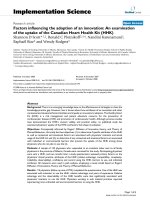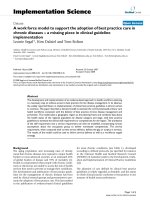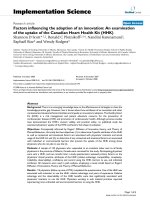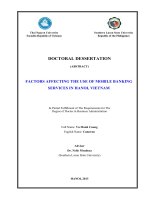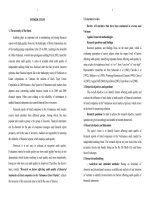the factors affecting the adoption of cost accounting system of selected travel agencies in hanoi, vietnam
Bạn đang xem bản rút gọn của tài liệu. Xem và tải ngay bản đầy đủ của tài liệu tại đây (206.27 KB, 44 trang )
Page1
ThAi nguyen University Southern Luzon STATE University
Socialist Republic of Vietnam Republic of Philippines
THE FACTORS AFFECTING THE ADOPTION OF COST
ACCOUNTING SYSTEM OF SELECTED TRAVEL
AGENCIES IN HANOI, VIETNAM
A RESEARCH PRESENTED TO THE FACULTY OF GRADUATE SCHOOL
SOUTHERN LUZON STATE UNIVERSITY LUCBAN, QUEZON, PHILIPPINES
THAI NGUYEN UNIVERSITY S.R. VIETNAM
IN PARTIAL FULFILLMENT OF THE REQUIREMENTS FOR THE DEGREE
DOCTORAL IN BUSINESS ADMINISTRATION
Name of Student : DOAN THI QUYNH ANH
English Name : ANGEL
Date of Birth : 05/01/1981
Course : SLSU-DBA1
Hanoi November, 2013
Page2
ACKNOWLEDGMENT
During the conduct of my thesis, I would like to give my sincere thank to
advisors: Prof. Dr. Pete Ooi; Dr. Edwin Bernal . The advisors help me with
detailed guidance and instruction so that I can complete my research.
Representatives from Southern Luzon State University, ThaiNguyen University,
ICT and academic affairs together with teachers and staffs in ICT office has
encouraged and helped from all the members in the class.
When conducting the research, I receive the enthusiastic support and
participation of directors and staffs of all enterprises that I have research.
Beside that, I always receive the encouragement and support form my
family.
I would like to express my sincere thanks to the advisors, staffs
participating in the research and my family for supporting me a lot.
Doan Thi Quynh Anh - Angel
Page3
CHAPTER 1
INTRODUCTION
1.1 Research Background
As Vietnam rides in the development of world economy, its
hospitality/tourism industry had gained remarkable leap. Demand in a wide-range
of hospitality-related products and services increased as people's living standard
improved. This included products and services in travel services which is one
sector in the multi billion-dollar world-wide hospitality industry.
Products and service in a travel agency are designed to satisfy special
needs of consumers such as understanding the culture, tradition and the historical
treasures of one locality, appreciating natural beauty of the place, experiencing the
climate, foods, events and festivities of the area, and a lot of activities simply
designed for sightseeing and for rest and recreation. The demand for travel
products and services is not very stable as it easily changes due to instability of
the climatic condition, and the economic and political situation of the particular
tourism destination. It therefore requires that players in the travel business to be
more creative and innovative to anticipate changes in the business landscape in
order to cushion the impact of slack time in the business.
Summarily, determining the cost of products and services in a travel
agency poses a great challenge for the firm’s accountants and managers in as
Page4
much as the business’ price offerings depend largely on the relevant costs.
Doubly challenging is the implementation of a firm’s policy on cost allocations
because this requires a deal of rationalization so as not to overburden one
product/service while others overburdened with unnecessary costs. This
therefore requires the identification and the use of appropriate cost driver to
achieved full rationalization of the system. Further, to achieve comparative and
competitive advantages, it is necessary that, costs associated with the
implementation of activities in major business functions along the value chains
should be analyzed as to whether these are value-adding or non-value adding
costs. Obviously, only value adding activities are client-focused activities and
therefore add to the achievement of the value expectations of the clients. While
cost accounting is a necessary requirement to achieve more in the travel business
in Hanoi, less has been benefiting fully from it. To determine the factors that
drive the sector to adopt cost accounting system is the major reason why this
research was conducted.
1.2. Statement of the Problem
This research focused on determining the factors which affect the adoption of the
cost accounting system of selected travel enterprises in Hanoi. Specifically, it tried
to find answers to the following research questions:
1. What is the profile of the respondents in terms of gender, age, position and
field of specialization?
Page5
2. What is the accountants’ and the managers’ perception of their level of
awareness and understanding, ease of use, and usefulness of cost accounting
system?
3. What factors are significantly affecting the attitude of the accountants and
the managers of travel agencies in adopting a cost accounting system?
4. Is there any difference in the accountants’ and the managers’ perception of
their level of awareness and understanding, ease of use, and usefulness of cost
accounting system?
5. Is there any difference between the accountants’ and the managers’
attitude towards adherence to the cost accounting system in the management of
costs in travel agencies?
1.3. Statement of Objectives
The general objective of this research was to determine the significant factors
affecting the adoption of cost accounting system for Hanoi-based travel agencies.
It seek to meet the requirements of the following specific objectives:
1. To determine the profile of the respondents in terms of gender, age,
position and field of specialization.
2. To describe the accountants’ and the managers’ perception of their level of
awareness and understanding, ease of use, and usefulness of cost accounting
system.
Page6
3. To identify the factors which significantly affect the attitude of the
accountants and the managers of travel agencies in adopting a cost accounting
system.
4. To statistically test the difference in the accountants’ and the managers’
perception of their level of awareness and understanding, ease of use, and
usefulness of cost accounting system.
5. To statistically test the difference between the accountants’ and the
managers’ attitude towards adherence to the cost accounting system in the
management of costs in travel agencies?
1.4. Hypotheses
The following hypotheses were tested using inferential statistical tools:
Hypothesis 1: There is no relationship between the accountants’ and the
managers’ perception of their level of awareness and understanding, ease of use,
and usefulness of cost accounting system and their attitude towards adoption of
the same cost accounting system in travel agencies.
Hypothesis 2: There is no difference in the accountants’ and the managers’
perception of their level of awareness and understanding, ease of use, and
usefulness of cost accounting system.
Page7
Hypothesis 3: There is no difference between the accountants’ and the managers’
attitude towards adherence to the cost accounting system in the management of
costs in travel agencies.
1.5. Significance of the study
This research conduct to analyze relationship between factors affecting the
cost accounting system in selected travel agencies. This study will be significant
to the following individuals and organizations:
For travel agencies and its key officers, this research indicates help finding
the key factors to apply the cost accounting system, they can use the results of this
research to find the factors affecting to the adoption of cost accounting system in
their enterprise.
Based on the results of this dissertation, managers and accountants in
travels agencies can making a plan to adopt the cost accounting management in
their enterprise with the target such as managial cost, , saving cost, decision
making
1.6. Scope and Limitation of the Study
Along with the system of the general theory of cost accounting system for
internal management, the thesis will analyze and assess the current perception of
cost accounting systems at some business travel company in Hanoi from which to
finding the factors affecting of adoption of cost accounting sytem for travel
Page8
agencies in the direction of modern cost accounting management system, which
help the cost management and providing useful information for the decision of the
administrator.
With the aim of improving accounting system in travel company in Hanoi,
and the number of enterprises tourism in Hanoil multiple, complex components
business in different fields, so the authors concentrate on research of the cost
accounting system of 7 business describe the model tour travel service in Hanoi,
including: A state-owned enterprise specialized in the field of business travel,
business travel in all four areas received international, send international visitors,
receives domestic tourists and domestic tourists on Hanoi recent years that is
Vietnam Travel and Marketing transports Company. Two enterprises belong to
VietNam national Administration of Tourism are the State of Investment and
Tourism Thang Loi and HaNoi Tourism company. Three enterprises represent
non-state enterprises as AsiaLink travel joint stock Company; New Horizons
travel joint stock company, SaoMai travel company. Besides, the authors also
conducted to survey 25 travel companies in the area of Hanoi.
1.7. Operational Definition of Terms
The following terms has been operationally defined:
Cost accounting system
Cost
Page9
Travel agency
Level of awareness and understanding of cost accounting system
Ease of use of cost accounting
Usefulness of cost accounting
CHAPTER II
REVIEW OF RELATED LITERATURE AND STUDIES
This chapter authors reviews the related literature and studies on travel
industry in Vietnam in general, Hanoi travel in particular. This chapter provides
the reader with sufficient theory about cost accounting, the usefulness of cost
accounting system. It will discuss theories framework and concepture framework ,
which is going to be evaluated in following chapters.
2.1. Review of Related Literature
2.1.1. The tourism industry and the travel sector
During the 53 years of establishment and development, travel industry has
always been interested in each period are determined location of tourism in the
economic development strategy of the country's socio-suit bridge revolution. In 53
years of development , not a long time for the development of an industry , but
can also see the strong upturn in both quantity and quality of Vietnam Tourism , is
Page10
a in important aggregate economic sectors, bringing profound cultural content that
is interdisciplinary, inter-regional and socialize high growth rate in recent times ,
including in crisis conditions Asian economic and natural disasters, widespread
epidemics, global conflicts and local wars and terrorism in many parts of the
world in recent years.
There is such a result , the entire tourism industry has actively
implemented seriously and synchronization solutions, both at work perfecting the
policy, state management, broadcast promotion, link and coordinate local
businesses, enhance the quality of services By the end of 2012, Vietnam had
1120 international tour operators; 11,840 tourist guides have been issued cards,
including cards 4,809 instructors and 7,031 local tourist guide card international
travel and the total number of tourist accommodation establishments all over the
country is estimated at 13,500 to 285,000 chamber, in which: 57 hotels 5 star 147
hotels 4 star,335 hotels 3 star.
Vietnam Tourism to identify some key tasks in 2013 include : Continue to
implement the development strategy of Vietnam's tourism in 2020, with a vision
to 2030, deployment of the planning scheme, other resorts according to the master
plan on development of Vietnam Tourism 2020 vision 2030 after being approved
by continued deployment tasks improve the quality and efficiency of tourism
statistics; promote activities E - tourism marketing and branding Vietnam tourism
logo and slogan associated with the new deployment scheme to attract tourists
from 8 key tourism markets of China , Japan , Korea , Malaysia , Thailand ,
Page11
Australia , France , Russia , to exploit tourism development Ha Long Bay and a
number of other prominent points to ensure the sustainability and high economic
efficiency, image building heritage tourism Vietnam, Ha Long Bay
2.1.2. Travel business in Hanoi
Hanoi is located and beautiful location, conveniently, is the capital, the
center of politics, economy, culture scientific, and important traffic of the country.
As one of the largest tourist centers of the country, Hanoi plays a very important
role in the tourism development of the country in general and in particular of
Tonkin. International tourist arrivals to Hanoi for about 30 % of visitors to
Vietnam. With the advantage of historical, cultural capital , domestic tourists to
Hanoi at the forefront of the country. Hanoi is also a center for receiving and
distribution of tourists travel to the northern region and the other regions in the
territory of Vietnam as well as to countries in the region .
Since several years , Hanoi has always been a number of prestigious travel
magazine as the World 's leading Travel and Leisure ( U.S. ) , Smart Travel Asia (
HKG ) held a vote and won the title of Top 10 tourist destinations most of Asia.
International visitors to Hanoi increasing number of customers rose by an
average of 18-20 % . In 2008, Ha Noi welcomes 1.3 million , in 2009 due to the
global economic crisis and the disease is 1.02 million visitors ; 2010 with a
celebration event in 1000 thousand years of Thang Long - Hanoi Cabinet and the
National Tourism Year, Hanoi arrivals increased, the total number of 1.7 million;
Page12
2011 welcomed 1.84 million international passengers; 2012 Hanoi welcomes over
2 million international tourist arrivals .
Markets domestic tourists to Hanoi large proportion of the country 's
leading , with an average annual passenger traffic accounted for over 20 % of
domestic tourists in Vietnam . In 2002, Hanoi welcomes 2.8 million , by 2009 had
brought 9.2 million , in 2010 to reach 10.6 million; in 2011 to reach 11.6 million;
in 2012 to reach over 12 million passengers .
Domestic Tourists to Hanoi with many different purposes and from all
provinces of the country , in which visitors to Hanoi for tourism purposes
traveling, visiting relatives and healing . Visitors to in Hanoi , stay at hotels 38.6
% , 24.4 % Guest House , Lodging and 21.8 % in the friends and relatives about
15.2 % ( by relatives and visitors rate Hanoi to therapy rather large ) . Shopping is
a pastime of tourists , especially domestic tourists . Spending on shopping
accounted for the highest proportion , 27.7 % of the total expenditure , followed
by eating 22.5 % , 22.1 % accommodation , transport and entertainment
respectively 10 , 2 and 9.4 % .
On Hanoi now has nearly 500 International travel agencies and nearly 500
domestic travel agencies, has about 50 companies and individual business
households transporting tourists. Hanoi focused cultural institutions of the country
such as the Opera House , the National Cinema Center, the major museums, the
Page13
performing arts theater folk as rowing, water puppetry very attractive with
international travelers and domestic .
2.1.3. Accounting as the language of business
Traditionally, accounting has been defined as the process of recording,
classifying and reporting the fianancial activities and transactions of a business
enterprise. The process of recording and classifying business transactions is
commonly referred to as bookeeping. The bookkeeping function of accounting
skill forms the foundation of much accounting activity. An accountant is usually
defined as “one who is skilled in accounting”. Ta the beginning of the twentieth
century, however, the role of accountantdid not extend much beyond a
bookkeeping function, that is, the keeping od records according to a set of well-
defined rules and procedures. At this time, accountants were generally reffered to
as “bookkeeper”. In the bissiness world of the twenty-first century the activities
and responsibilities af accountants extend far beyond mere bookeeping and the
keeping records. They include the interpretation and analysis of accounting report,
the design and operation of computer based system, the planning and conduct of
business activities, and the understanding the complex accounting regualtions that
have accumulated over many years.
Accountants serve a potentially wide variety of user groups. The many
different users of accounting informarion include the owners or shareholders of a
business entity, the people who have lend money to the entity, the entitys’
Page14
employees, government agencies and other social and political interrest group,
such as environment group anf trade unions. In providing information for these
users, accountants frequently need to consider more thanjust fianacial factors.
Accounting has a wide-ranging fuanction and hence abroad definition of
the field of accounting is needed, one that embraces the variety of professional
activities engaged in by accountants. Serveral years ago a committee og the
American Accounting Association defined accounting beyond its mere traditional
definition (the recording, classifying and reporting of transaction). This committee
defined accounting in a broader and more modern context as the process of
identifying, measuring and communicating economic information to permit
informed judgements and decisions by users of information.
Accounting is called the language of the business in the sense that the
responsibility of learning accounting is very similar to the task of erudition a new
language ,it is complicated by the fact that heaps words used in accounting mean
almost the same but not fairly the same thing as the identical words scrounging in
everyday non -accounting usage.
2.1.4. Cost accounting and cost accounting system – uses and
importance
Cost accounting is a process of collecting, analyzing, summarizing and
evaluating various alternative courses of action. Its goal is to advise the
management on the most appropriate course of action based on the cost efficiency
Page15
and capability. Cost accounting provides the detailed cost information that
management needs to control current operations and plan for the future. Since
managers are making decisions only for their own organization, there is no need
for the information to be comparable to similar information from other
organizations. Instead, information must be relevant for a particular environment.
Cost accounting information is commonly used in financial
accounting information, but first we are concentrating on its use by managers to
make decisions.
Unlike the accounting systems that help in the preparation of financial
report periodically, the cost accounting systems and reports are not subject to rules
and standards like the . As a result, there is wide variety in the cost accounting
systems of the different companies and sometimes even in different parts of the
same company or organization.
A method of accounting in which all costs incurred in carrying out
an activity or accomplishing a purpose are collected, classified, and recorded.
This data is then summarized and analyzed to arrive at a selling price, or to
determine where savings are possible.In contrast to financial accounting (which
considers money as the measure of economic performance) cost accounting
considers money as the economic factor of production.
Cost accounting is an approach to evaluating the overall costs that are
associated with conducting business. Generally based on standard accounting
practices, it is one of the tools that managers utilize to determine what type and
Page16
how much expenses is involved with maintaining the current business model. At
the same time, the principles of cost accounting can also be utilized to project
changes to these costs in the event that specific changes are implemented.
2.1.5. Cost management in travel agency
The implementation of a cost accounting system is an important step for a
service business. Implementation begins with identification of the correct costing
system for the business, moves on to deployment of the system and finishes with
post-deployment support to train employees on how to use the system effectively.
Best practices in cost-system implementation focus on all three parts of the
implementation process.
There are cost accounting systems designed for the sole proprietorship on
up to the largest multinational corporation. It is important remember that bigger
isn't necessarily better. Service business owners should look to implement a cost
accounting system that is matched to the complexity of their business. Less-
complex companies may be best using an off-the-shelf software system or a
system that is integrated into their current accounting software. However,
companies that have many products or complex manufacturing processes may
wish to seek a more customized solution.
Implementing a cost accounting system is much easier when you only
have to implement the system once. Managers should be careful to choose a cost
accounting system that is scalable to the company. For example, even if you only
Page17
manufacture a handful of products currently, you may wish to implement a cost
accounting system that can handle more products as your offerings grow.
As your company implements a cost accounting system, it is important to
involve employees in the process. Employees who are involved in the process of
implementing the system are more likely to have bought in to the transition. Not
only does this help employees understand the system more quickly, but these
employees can serve as ambassadors to other employees who weren't involved in
implementation. Often, the employees who were involved in implementation are
more successful in increasing trust of the new system than management. This
occurs because other employees view these employees as having less incentive to
blindly approve of the implementation.
Most service business owners are experts in their fields, but few are
experts in the implementation of accounting systems as well. Managers and small-
business owners should consider consultation with a professional accountant
before spending time and resources choosing and implementing a cost accounting
system. The money that you spend seeking professional help can buy you time to
focus on business operations. However, service business owners who seek
consultants should be mindful and ask the consultants if they receive any
commission from the makers of the cost accounting system. If so, you may wish
to seek the advice of someone more impartial.
2.2. Related Studies
Page18
Behavior costs means that these costs will change how business activity
levels change. This classification needs planning, cost control and actively
regulate the cost of management. According to this classification, the entire cost
of the enterprise are classified into:
Variable costs: Are the expenses related proportional to the level of activity,
variable costs for one unit of product is stable does not change, the total variable
costs change when output changes and variable cost is zero when inactive.
- The fixed cost: The cost does not change when the level of activity changes (to
the extent appropriate), but when 1 unit based, the costs vary inversely with the
level of activity . However, when the level of development activities beyond the
scope of compliance, cost forced to change to fit in with the development of the
activity level. Usually the fees include: equipment depreciation costs, advertising
costs, rent, insurance.
- Mixed Cost: Is the cost of which itself includes variable costs and fixed fee
element. In particular, the charges reflect the cost basis, at least to maintain the
service and to keep the service always ready to serve the state. While the variable
costs reflect the actual service or in excess of the base rate so this section will vary
proportionally with the level of use on the baseline
The focus of management accounting is the field of cost, so the organization of
scientific management accounting and reasonable will ensure information quality,
reliable, and purpose of management accounting more charge is to provide the
appropriate cost information, useful, timely decision making of corporate
Page19
governance. So, for the cost and management accounting not only aware of the
cost, such as financial accounting, cost is perceived by the method of decision-
identifying information. Cost may be the actual cost associated with the daily
business operations while implementing, testing, decision-making, can also cost is
the estimated cost to implement the project, the costs lost when selecting schemes
ignore business opportunities. Meanwhile in management accounting need to pay
attention to the choice, comparison purposes, the business environment rather than
focusing on proven by evidence and documents.
Page20
Fig 1: Classification of cost in travel bussiness
2.3. Theoretical framework
Management accounting also to collect other information relevant to
business decisions, such as: information on labor, information on the use of assets
To collect good information to meet the information needs of past and future
information of business management, accounting management incorporates the
analysis of this information to advise administrators business plan choice.
Businesses to survive and stable development should have a reasonable business
strategy. So should have expected more, specific to each period as well as the
production process. This means that need to estimate production. The process of
building cost estimates associated with the business of governance, facility
conditions promote positive, proactive, innovative facilities and the feasibility of
the estimates were made, at the same time facilitate strengthen inspection and
control.
Business processes of the enterprise consists of many processes are closely related
to each other. Each different process management requirements also vary,
requiring specific target estimate to suit each specific business process. In the
enterprise business system production estimates include many targets, but
estimates of consumption is a major factor affecting the entire line estimation of
the business, its impact and driven to the other estimates. Consumption estimates
Page21
as the basis for estimation of production or purchase to meet the demand for the
production or sale of products. Based on production estimates for estimation of
production costs which determine the estimates defined business results.
Therefore, in the estimation process to determine the basic estimates as a basis
from which to build a system estimates the scientific production estimates,
reasonable, feasible basis for organizations operating business activities to achieve
the highest efficiency.
There are two methods of estimation of business is flexible static estimates and
estimates. the cost estimates for a proposed activity level, and estimate flexible
cost estimates for a level of activity can occur. Data from static estimates are
important in planning but has little effect on the control because the actual level of
activity rarely coincides with the plan. In contrast, the estimated useful flexibility
for administrators to control activities by comparing the actual results and
estimates data for the same level of activity.
2.4. Conceptual Framework
From the theories and concept above, I suggest the relation of variables to
factors affecting the adoption of cost accounting system in travel agencies as follows:
Page22
Fig 2 Conceptual Framework
Adherence to Cost Accounting System
in Cost Management
Cost Accounting System Adoption Factors
Respondents’ Profile
¾ Gender
¾ Age
¾ Position
¾ Field of Specialization
Accountants’ & Managers’
Perception on Cost Accounting
System
¾ Perceived level of
awareness &
understanding
¾ Perceived ease of use
¾ Perceived usefulness
Accountants’ & Managers’ Attitude
Toward Adoption of Cost
Accounting System
Page23
CHAPTER III
METHODOLOGY
The research used both quantitative and qualitative methods to answer the
enumerated research questions. Survey questionnaires were designed to analyze
the factors affecting the adoption the cost accounting system in travel agencies
Sampling method, data collection method and tools for data collection are
discussed in this chapter. Finally, statistical tools to process and analyze the
collected information for the dissertation research shall be tackled.
3.1 Research design
In this research, four groups of parameters were used to focus on the aspects of
perception of Level of Awareness and Understanding of Cost Accounting System,
perception of easy of use of Cost Accounting System , perception of usefulness of
Cost Accounting System, Attitude of the Accountants and the Managers of Travel
Agencies in Adopting a Cost Accounting System. All the variables are tabulated
in Table 3.1. There are four independent variables,specifically,” perceived of
Level of Awareness and Understanding” "perceived usefulness", "perceived ease
of use". Each independent variable measured by four to ten questions related cost
accounting system. A total of 23 questions were conducted to four aspects of
the
adoption the cost accounting system in travel agencies.
.2 Determination of sample size
Page24
According to the Vietnam National Administration of tourism, in 2012,
there
were 500 travel agencies subscribers in Hanoi. Dissertation uses the Slovins
formula to difine the sample size for the survey.
n =
2
1 Ne
N
+
where n = A sample size
M = Population size
e = Probability of error committed due to the use of sample instead of
population.
The error level in sample survey was chosen to be at 5%.
Thus, the sample size of the survey is 150 respondents.
3.3 Research instrument
To measure the factors that affect customer loyalty in mobile
communication services, the questionnaire using the Likert scale with five levels:
5: strongly agree; 4: agree; 3: normal; 2: disagree and 1: strongly disagree.
The questionnaire was designed in four parts:
Part one: Perceived Level of Awareness and Understanding of Cost Accounting System
Part two: Perceived Ease of Use of Cost Accounting System
Part three: Perceived Usefulness of Cost Accounting System
Part four: Attitude Toward Adherence to Cost Accounting System inCost Management




